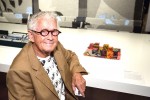Weaving was considered feminine when James Bassler first secretly worked with fiber in helping his father hook rugs in the 1930s.
In the privacy of the family home, 6-year-old Bassler watched his father, a major league baseball player, trade his catcher’s mitt for strips of dyed silk.
Bassler, a UCLA alumnus and previous faculty member, is among 36 artists who contributed to the Fowler Museum’s “The Box Project: Uncommon Threads.” The exhibition, which will be open from Sept. 11 to Jan. 15, explores the use of fibers, such as thread, silk cocoon and tree root, in art. The exhibit is the cumulative result of Bassler’s history with fiber, beginning as a passion practiced in secret, then becoming a craft he taught UCLA students and resulting in work proudly displayed at the Fowler, he said.
Bassler arrived as a sociology student at UCLA in 1953 but immediately found interest in art. But once he began taking art courses, he was drafted into the army during the Korean conflict in the Cold War.
After military service in Europe, Bassler said he longed for a new pursuit and left on a freighter departing for Hong Kong and Tokyo, where he first fell in love with Asian textiles.
Bassler was struck by the integration of textiles in everyday life in the countries he visited: When the freighter stopped to unload cargo in Mumbai, India, Bassler said he wandered the streets and stumbled upon a pavilion set up in tribute to Gandhi, where he watched locals spin and weave cotton to demonstrate how Gandhi had promoted spinning to support the independence movement.
In Indonesia, Bassler observed the craft of using beeswax to make elaborate patterns in the textiles. In Kyoto, Japan, he witnessed people rinsing their dyed silks in the river.
“This was what I needed — to fill up with (the knowledge) of how to survive in the world with the simplest of techniques,” Bassler said. “It was a whole lot more interesting to me than putting up missiles in England.”
When he returned to America in 1960, Bassler resumed studying art at UCLA and trained to be a teacher. He attended Professor Bernard Kester’s weaving class, which he said was relegated to the basement of Royce Hall. The looms took up a lot of space, so the class was separated from the other more popular visual arts courses the department housed upstairs.
Bassler said he graduated with a specialization in fiber but felt opposition towards his medium of choice throughout his master’s program. For his master’s show, Bassler was prohibited from displaying his work in the main art gallery and instead displayed his work by the pool at the Sunset Canyon Recreation Center.
Bassler said fiber’s association with women withheld it from wider acceptance in the art world. While Bassler struggled against the resistance to fiber as an art form for much of his life, he said the industry has become more accepting, and he has recently seen a resurgence of interest in fiber pieces created in the 1960s.
After graduating, Bassler taught ceramics as a junior high school teacher and then to teenage girls in Oaxaca, Mexico. He eventually joined UCLA’s faculty to teach undergraduate form and color classes. When he later became the chair of the Department of Art, Design, Art History at UCLA, he said he struggled to keep fiber in the program.
It was a turbulent time because the chancellor proposed we get rid of the undergraduate program in all of the arts unless you put together a curriculum that is focused on the future,” Bassler said.
The Department of Art, Design, Art History switched to the more electronic focused Design | Media Arts, and Bassler moved to the department of World Arts and Culture. While at UCLA, Bassler also taught a class on the history of textiles in the Americas at the Fowler’s Center for the Study of Regional Dress.
He said teaching helps him share his love of the unconventional art form to new students.
Bassler always tried to make weaving interesting to the students by finding ways to relate the art form directly to their lives. He discussed indigo’s involvement in denim blue jeans and brought in little cochineal bugs from cacti that were used to make common red dyes, said Barbara Sloan, previous associate director of the Fowler’s Center for the Study of Regional Dress.
“He’s like the Pied Piper – the kids loved him,” Sloan said. “This wasn’t what students were getting in their usual classes because it wasn’t just a lecture, it was more hands on.”
Carrie Burckle-Sullivan, one of Bassler’s students when he taught art at California State University, Long Beach, said Bassler’s dedication and enthusiasm as an instructor was magnetic.
“No matter (Bassler’s) age, he just brings a youthful spirit and exuberance in his teaching,” Burckle-Sullivan said.
Bassler’s fiber art today has graduated from the basement to the showroom. His contribution to “The Box Project” is a series of nine two-inch cubes covered in tie-dye woven patterns to match the cloth they rest on. The piece, entitled “Boxed Blocks,” appears different based on the perspective of the viewers, since each face of the cube is a different color.
“There’s almost a retro kind of thing where people are beginning to appreciate that which was done then,” Bassler said. “All of a sudden (fiber) isn’t quite as foreign as it once was.”
